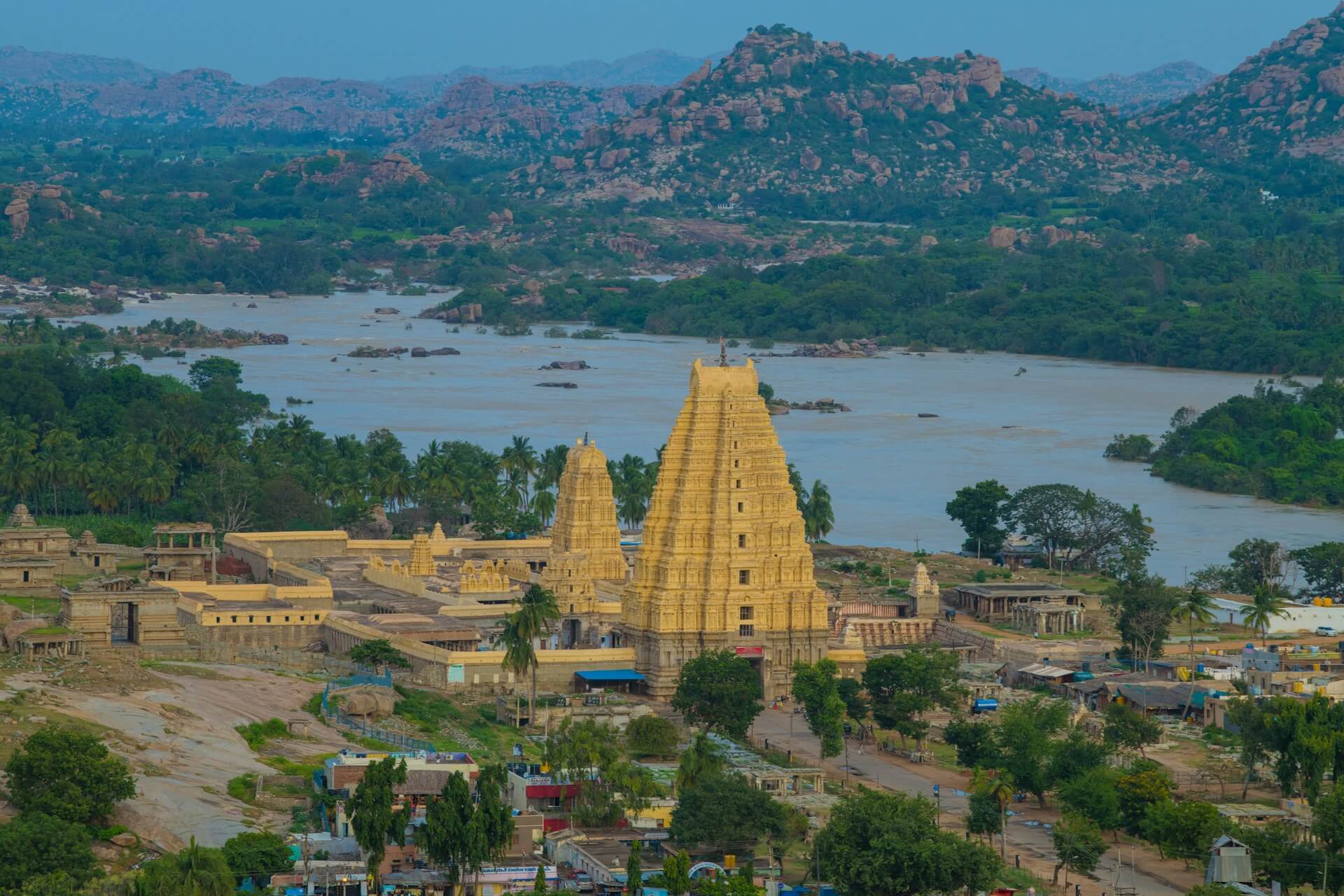Hampi, Badami & Anegundi Travel Guide: Exploring Beauty
History
Hampi
Hampi, Badami, and Anegundi, UNESCO World Heritage sites, were once the flourishing capitals of their respective empires. Founded in the 14th century, this ancient city was a significant center for commerce and culture. It attracted traders from Persia and Portugal, and its wealth was renowned across continents. Exploring Hampi, Badami, and Anegundi reveals the rich history embedded in the ruins of palaces, temples, and markets. Among them, the Virupaksha Temple stands as the oldest and still functioning religious site..
Badami
Badami, known for its rock-cut cave temples, was the capital of the Chalukya dynasty in the 6th century. The Chalukyas were great patrons of art and architecture, which is evident from the intricate carvings and sculptures in the caves. These temples, carved into the red sandstone cliffs, depict various Hindu deities and mythological scenes, reflecting the artistic prowess of the era.
Anegundi
Anegundi, often overshadowed by Hampi, is equally rich in history. It predates the Vijayanagara Empire and is considered one of the oldest plateaus on the planet. Anegundi is believed to be the ancient kingdom of Kishkindha from the Ramayana. The ruins of the Anegundi Fort and the Pampa Sarovar, a sacred lake, are significant historical and mythological landmarks.
Geography
Hampi is located in the state of Karnataka, southern India, along the banks of the Tungabhadra River. The landscape is dominated by rocky terrain and lush green paddy fields. The unique topography, with its giant boulders, makes it a picturesque location. Badami, situated in the Bagalkot district of Karnataka, is known for its rugged red sandstone cliffs. These cliffs house the famous rock-cut temples and surround the serene Agastya Lake. Anegundi, across the Tungabhadra River from Hampi, shares a similar terrain with rocky hills and ancient ruins scattered across the landscape.
How to Reach Hampi
By Air
The nearest airport to Hampi is Hubli Airport, approximately 144 kilometers away. Another option is Kempegowda International Airport in Bangalore, about 350 kilometers from Hampi. From these airports, you can hire a taxi or take a bus to Hampi.
By Road
Hampi is well-connected by road. You can take a direct bus from Bangalore, Hyderabad, or Goa. The Karnataka State Road Transport Corporation (KSRTC) and several private operators run regular bus services to Hampi.
By Railway
The closest railway station to Hampi is Hospet Junction, around 13 kilometers away. Hospet is well-connected to major cities like Bangalore, Hyderabad, and Goa. From Hospet, you can take a taxi or a local bus to reach Hampi.
Travel Routes
From Bangalore
The road distance from Bangalore to Hampi is around 350 kilometers. The NH48 and NH50 routes are the most common, passing through Chitradurga and Hospet. This scenic route takes approximately 7-8 hours by car or bus.
From Hyderabad
Hampi is about 370 kilometers from Hyderabad. The route via NH44 and NH167 is commonly used, passing through Raichur and Hospet. The journey takes about 8-9 hours by car or bus.
From Goa
The distance from Goa to Hampi is approximately 310 kilometers. The NH66 and NH67 routes are popular, passing through Hubli and Hospet. This journey takes around 7-8 hours by car or bus.
Travel and Hotel Arrangements
In Hampi, Badami, and Anegundi, travelers can choose from a variety of accommodation options, ranging from budget guesthouses to luxury resorts. Some popular places to stay include the Hampi Boulders Resort, Clarks Inn Hampi, and the Heritage Resort Hampi. In Badami, you can stay at the Badami Court Hotel or the Heritage Resort Badami. Anegundi offers more homestay options, providing a local experience.
To ensure a comfortable stay, it’s recommended to book accommodation in Hampi, Badami, and Anegundi well in advance, especially during the peak tourist season from October to February.
Different Modes of Transport in Hampi and Nearby
Exploring Hampi, Badami, and Anegundi can be done on foot, by bicycle, or by renting a scooter. Bicycles and scooters are available for rent at various shops in the area. Auto-rickshaws and local buses are also available for longer distances. In Badami, auto-rickshaws and taxis are commonly used to visit the cave temples and surrounding sites. In Anegundi, walking and cycling are popular ways to explore the small village and its attractions.
Places to Visit and Best Times
Hampi
- Virupaksha Temple
- Best Time: Morning.
- Description: Dedicated to Lord Shiva, this temple is a major pilgrimage site and features intricate carvings and a towering gopuram.
- Vittala Temple
- Best Time: Evening.
- Description: Famous for its stone chariot and musical pillars, the Vittala Temple is an architectural marvel. The evening light and sound show is a must-see.
- Hemakuta Hill
- Best Time: Sunrise.
- Description: Offers panoramic views of Hampi with numerous small temples and pavilions. The sunrise view is particularly stunning.
- Matanga Hill
- Best Time: Sunrise or sunset.
- Description: Provides a bird’s-eye view of Hampi. The climb is moderately challenging, but the view from the top is worth it.
- Lotus Mahal
- Best Time: Afternoon.
- Description: An example of Indo-Islamic architecture, the Lotus Mahal features delicate arches and a lotus-shaped dome.
- Hazara Rama Temple
- Best Time: Morning.
- Description: Known for its bas-reliefs depicting scenes from the Ramayana. The temple was a private shrine of the Vijayanagara kings.
- Tungabhadra River
- Best Time: Early morning or late afternoon.
- Description: Enjoy a coracle ride or relax by the riverside. The river offers a unique perspective of the ruins along the riverbanks and is a serene spot for reflection.
- Queen’s Bath
- Best Time: Morning.
- Description: A beautiful structure used by the royal family, showcasing the opulent lifestyle of the Vijayanagara kings.
- Elephant Stables
- Best Time: Morning.
- Description: An impressive array of domed chambers that housed the royal elephants, reflecting the importance of these majestic animals in the royal household.
Badami
- Badami Cave Temples
- Best Time: Morning.
- Description: Renowned for intricate carvings and sculptures, these rock-cut temples depict various Hindu deities and mythological scenes.
- Agastya Lake
- Best Time: Sunset.
- Description: Surrounded by hills and temples, offering a tranquil setting for relaxation and reflection. The sunset view over the lake is breathtaking.
- Bhutanatha Group of Temples
- Best Time: Evening.
- Description: Set against the backdrop of Agastya Lake, these sandstone temples are dedicated to Lord Shiva. They are known for their serene setting and intricate carvings, inviting visitors to immerse themselves in ancient spirituality and architectural beauty.
- Banashankari Temple
- Best Time: Morning.
- Description: A popular pilgrimage site dedicated to Goddess Banashankari Amma, attracting devotees from far and wide.
- Badami Fort
- Best Time: Early morning.
- Description: Offers panoramic views of the town and surrounding landscape, providing insights into the military architecture of the Chalukya period.
Anegundi
- Anegundi Fort
- Best Time: Early morning.
- Description: Reflects the strategic importance of Anegundi in the defense of the Vijayanagara Empire, with ancient walls, gateways, and temples.
- Pampa Sarovar
- Best Time: Late afternoon.
- Description: A sacred lake associated with the Ramayana, offering a peaceful environment for meditation and reflection.
- Navabrindavanam
- Best Time: Daytime.
- Description: A small island on the Tungabhadra River housing the samadhis of nine Madhva saints, revered by followers of the Madhva tradition.
- Rishimukh Island
- Best Time: Afternoon.
- Description: Nestled amidst lush greenery, this island holds mythical significance as the legendary meeting place of Lord Rama and Hanuman, enhancing its allure and spiritual appeal.
- Durga Temple
- Best Time: Morning.
- Description: An ancient temple dedicated to Goddess Durga, known for its simple yet elegant architecture and historical significance.
- Sanapur Lake
- Best Time: Sunset.
- Description: A picturesque reservoir surrounded by boulder-strewn landscapes, offering a serene setting for boating and picnicking.
Exploring other activities in Hampi, Badami, and Anegundi
Coracle Ride
A coracle ride in Hampi offers a unique and serene way to experience the beauty of the Tungabhadra River and its surrounding landscapes. Coracles are traditional, circular boats made of bamboo and waterproofed with either plastic or tar. This ancient mode of transport provides an authentic way to explore the river, weaving through lush greenery, rocky outcrops, and ancient ruins. As you glide along the water, the rhythmic paddling of the boatman creates a soothing ambiance, perfect for soaking in the scenic views and observing local wildlife. The ride often includes navigating past small waterfalls, historic sites, and, occasionally, spotting playful monkeys along the banks. It’s an enchanting experience that combines nature, history, and adventure, making it a must-do activity in Hampi.
Cliff Jumping
Cliff jumping in Hampi is an exhilarating activity that attracts thrill-seekers looking for an adrenaline rush. The region’s unique topography, characterized by rugged boulders and rocky cliffs, provides ideal spots for this adventure sport. One of the popular locations for cliff jumping is Sanapur Lake, where adventurers can leap from various heights into the refreshing waters below. Safety is paramount, and it’s recommended to check the water depth and ensure there are no submerged rocks before jumping. Cliff jumping in Hampi offers a perfect blend of excitement and natural beauty, allowing participants to enjoy stunning panoramic views while experiencing the sheer thrill of free-falling into the pristine lake waters.
Camping on Hippie Island
Camping on Hippie Island, also known as Virupapur Gadde, is a tranquil and bohemian experience that immerses you in the laid-back vibe of Hampi. Located across the Tungabhadra River from the main ruins, this island is famous for its relaxed atmosphere, scenic beauty, and vibrant backpacker culture. Setting up camp here means being surrounded by lush paddy fields, striking boulder-strewn landscapes, and picturesque sunsets. The island offers several designated camping spots, with some local cafes and guesthouses providing camping gear and basic amenities. Nights on Hippie Island are magical, often filled with bonfires, stargazing, and meeting fellow travelers, creating a community feel. The serene environment, coupled with the freedom to explore nearby attractions at your own pace, makes camping on Hippie Island an unforgettable experience.
Bouldering
Hampi is a world-renowned destination for bouldering, attracting climbers from around the globe to test their skills on its distinctive granite formations. The landscape is dotted with countless boulders of varying sizes and difficulties, making it a perfect playground for both beginners and experienced climbers. Areas like Hemakuta Hill, Matanga Hill, and the region around the Virupaksha Temple are popular bouldering spots, offering a range of problems that challenge climbers’ strength, technique, and creativity. The bouldering community in Hampi is vibrant and welcoming, with many local and visiting climbers sharing tips and encouragement. The combination of physical challenge and the opportunity to climb amidst stunning historical ruins and natural beauty makes bouldering in Hampi a unique and rewarding experience.
Food
The culinary scene in Hampi is as diverse and intriguing as its historical landscape. Visitors can savor a variety of dishes that cater to different palates, ranging from traditional South Indian cuisine to international fare. Local eateries and street vendors offer delicious South Indian staples such as dosa, idli, vada, and the flavorful thali, which is a platter of various regional dishes. For those craving a taste of home or something different, there are numerous cafes and restaurants on Hippie Island and near the Hampi Bazaar area that serve everything from Israeli to Italian and continental dishes. Fresh fruit juices, smoothies, and an array of snacks like samosas and pakoras are also readily available. The fusion of local flavors with global influences ensures that every meal in Hampi is a delightful experience, reflecting the region’s cultural richness and hospitality.
Conclusion
Hampi, Badami, and Anegundi offer a rich tapestry of history, culture, and natural beauty. Exploring these ancient sites provides a unique glimpse into India’s glorious past, complemented by the stunning landscape that surrounds them. If you’re a history buff, a photography enthusiast, or an avid traveler, these destinations have something to offer everyone. The intricate carvings, grand temples, serene lakes, and mythological connections create a captivating and immersive experience. Plan your trip meticulously, and you will be rewarded with an unforgettable journey through time, exploring the grandeur and mystique of Hampi, Badami, and Anegundi. The rich cultural heritage, combined with the natural beauty of the region, ensures that your visit will be a memorable one, filled with discoveries and reflections on the splendor of ancient India.
For customised tour mail us – nomadictribesinfo@gmail.com or contact@nomadictribes.in or Call – 9324106377
For more tours visit Nomadic Tribes





 Message Us
Message Us